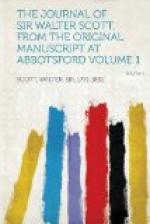hoping to make some impression, said, “Do not
hurt my servant,” to which the principal brigand
replied, “If he dares to resist, shoot him.”
The man who stood over Mr. Hunt unfortunately took
the captain at the word, and his shot mortally wounded
the unfortunate gentleman and his wife, who both died
next day at our landlady’s, Miss Whyte, who had
the charity to receive them that they might hear their
own language on their deathbed. The Neapolitan
Government made the most uncommon exertions.
The whole of the assassins were taken within a fortnight,
and executed within a week afterwards. In this
wild spot, rendered unpleasing by the sad remembrance
of so inhuman an accident, and the cottages which
served for refuge for so wretched and wild a people,
exist the celebrated ruins of Paestum. Being without
arms of any kind, the situation was a dreary one,
and though I can scarce expect now to defend myself
effectually, yet the presence of [
illegible]
would have been an infinite cordial. The ruins
are of very great antiquity, which for a very long
time has not been suspected, as it was never supposed
that the Sybarites, a luxurious people, were early
possessed of a style of architecture simple, chaste,
and inconceivably grand, which was lost before the
time of Augustus, who is said by Suetonius to have
undertaken a journey on purpose to visit these remains
of an architecture, the most simple and massive of
which Italy at least has any other specimen. The
Greeks have specimens of the same kind, but they are
composed not of stone, like Paestum, but of marble.
All this has been a discovery of recent date.
The ruins, which exist without exhibiting much demolition,
are three in number. The first is a temple of
immense size, having a portico of the largest columns
of the most awful species of classic architecture.
The roof, which was composed of immense stones, was
destroyed, but there are remains of the Cella, contrived
for the sacrifices to which the priests and persons
of high office were alone [admitted].
A piece of architecture more massive, without being
cumbrous or heavy, was never invented by a mason.
A second temple in the same style was dedicated to
Ceres as the large one was to Neptune, on whose dominion
they looked, and who was the tutelar deity of Paestum,
and so called from one of his Greek names. The
fane of Ceres is finished with the greatest accuracy
and beauty of proportion and taste, and in looking
upon it I forgot all the unpleasant feelings which
at first oppressed me. The third was not a temple,
but a Basilica, or species of town-house, as it was
called, having a third row of pillars running up the
middle, between the two which surrounded the sides,
and were common to the Basilica and temple both.
These surprising public edifices have therefore all
a resemblance to each other, though also points of
distinction. If Sir William Gell makes clear his
theory he will throw a most precious light on the




